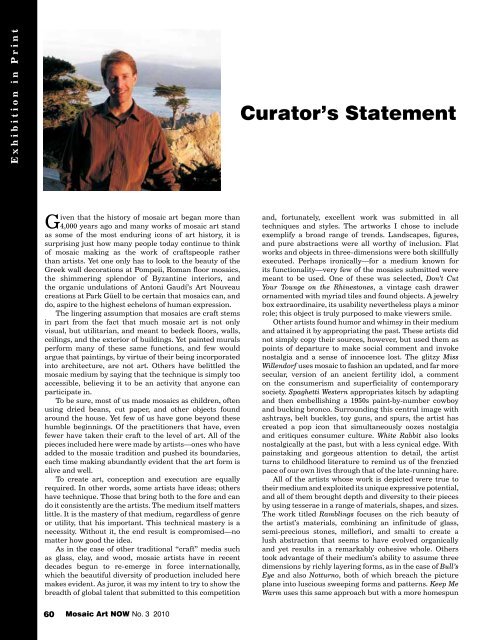You also want an ePaper? Increase the reach of your titles
YUMPU automatically turns print PDFs into web optimized ePapers that Google loves.
E x h i b i t i o n i n P r i n t<br />
Given that the history of mosaic art began more than<br />
4,000 years ago and many works of mosaic art stand<br />
as some of the most enduring icons of art history, it is<br />
surprising just how many people today continue to think<br />
of mosaic making as the work of craftspeople rather<br />
than artists. Yet one only has to look to the beauty of the<br />
Greek wall decorations at Pompeii, Roman floor mosaics,<br />
the shimmering splendor of Byzantine interiors, and<br />
the organic undulations of Antoni Gaudí’s <strong>Art</strong> Nouveau<br />
creations at Park Güell to be certain that mosaics can, and<br />
do, aspire to the highest echelons of human expression.<br />
The lingering assumption that mosaics are craft stems<br />
in part from the fact that much mosaic art is not only<br />
visual, but utilitarian, and meant to bedeck floors, walls,<br />
ceilings, and the exterior of buildings. Yet painted murals<br />
perform many of these same functions, and few would<br />
argue that paintings, by virtue of their being incorporated<br />
into architecture, are not art. Others have belittled the<br />
mosaic medium by saying that the technique is simply too<br />
accessible, believing it to be an activity that anyone can<br />
participate in.<br />
To be sure, most of us made mosaics as children, often<br />
using dried beans, cut paper, and other objects found<br />
around the house. Yet few of us have gone beyond these<br />
humble beginnings. Of the practitioners that have, even<br />
fewer have taken their craft to the level of art. All of the<br />
pieces included here were made by artists—ones who have<br />
added to the mosaic tradition and pushed its boundaries,<br />
each time making abundantly evident that the art form is<br />
alive and well.<br />
To create art, conception and execution are equally<br />
required. In other words, some artists have ideas; others<br />
have technique. Those that bring both to the fore and can<br />
do it consistently are the artists. The medium itself matters<br />
little. It is the mastery of that medium, regardless of genre<br />
or utility, that his important. This technical mastery is a<br />
necessity. Without it, the end result is compromised—no<br />
matter how good the idea.<br />
As in the case of other traditional “craft” media such<br />
as glass, clay, and wood, mosaic artists have in recent<br />
decades begun to re-emerge in force internationally,<br />
which the beautiful diversity of production included here<br />
makes evident. As juror, it was my intent to try to show the<br />
breadth of global talent that submitted to this competition<br />
60 <strong>Mosaic</strong> <strong>Art</strong> <strong>NOW</strong> No. 3 2010<br />
Curator’s Statement<br />
and, fortunately, excellent work was submitted in all<br />
techniques and styles. The artworks I chose to include<br />
exemplify a broad range of trends. Landscapes, figures,<br />
and pure abstractions were all worthy of inclusion. Flat<br />
works and objects in three-dimensions were both skillfully<br />
executed. Perhaps ironically—for a medium known for<br />
its functionality—very few of the mosaics submitted were<br />
meant to be used. One of these was selected, Don’t Cut<br />
Your Tounge on the Rhinestones, a vintage cash drawer<br />
ornamented with myriad tiles and found objects. A jewelry<br />
box extraordinaire, its usability nevertheless plays a minor<br />
role; this object is truly purposed to make viewers smile.<br />
Other artists found humor and whimsy in their medium<br />
and attained it by appropriating the past. These artists did<br />
not simply copy their sources, however, but used them as<br />
points of departure to make social comment and invoke<br />
nostalgia and a sense of innocence lost. The glitzy Miss<br />
Willendorf uses mosaic to fashion an updated, and far more<br />
secular, version of an ancient fertility idol, a comment<br />
on the consumerism and superficiality of contemporary<br />
society. Spaghetti Western appropriates kitsch by adapting<br />
and then embellishing a 1950s paint-by-number cowboy<br />
and bucking bronco. Surrounding this central image with<br />
ashtrays, belt buckles, toy guns, and spurs, the artist has<br />
created a pop icon that simultaneously oozes nostalgia<br />
and critiques consumer culture. White Rabbit also looks<br />
nostalgically at the past, but with a less cynical edge. With<br />
painstaking and gorgeous attention to detail, the artist<br />
turns to childhood literature to remind us of the frenzied<br />
pace of our own lives through that of the late-running hare.<br />
All of the artists whose work is depicted were true to<br />
their medium and exploited its unique expressive potential,<br />
and all of them brought depth and diversity to their pieces<br />
by using tesserae in a range of materials, shapes, and sizes.<br />
The work titled Ramblings focuses on the rich beauty of<br />
the artist’s materials, combining an infinitude of glass,<br />
semi-precious stones, millefiori, and smalti to create a<br />
lush abstraction that seems to have evolved organically<br />
and yet results in a remarkably cohesive whole. Others<br />
took advantage of their medium’s ability to assume three<br />
dimensions by richly layering forms, as in the case of Bull’s<br />
Eye and also Notturno, both of which breach the picture<br />
plane into luscious sweeping forms and patterns. Keep Me<br />
Warm uses this same approach but with a more homespun


